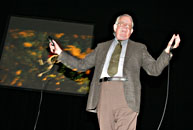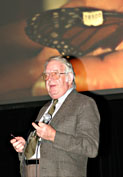Minding the monarchs
"There is our wonderful creature," said the white-haired, bespectacled man on stage last week in Moyse Hall. Projected on the screen behind him was a giant monarch butterfly, similar to those many of us will have seen recently flitting around the shores of the St. Lawrence, supping on nectar from goldenrods and asters in preparation for their 3,900-kilometre flight to central Mexico.

Lepidopterist Lincoln Brower in Mexico
Showing the slides one by one, the 72-year-old storyteller recounted the saga and situation of the black and orange beauty, Danaus plexippus ("milkweed butterfly" — the common weed is the sole food of the monarch caterpillar). It's a story he has told in progressive variations as a biologist and concerned citizen for nearly half a century.
So much has changed in the understanding of this famous butterfly, unique for its migration. When Lincoln Brower, invited here to speak by the McGill School of Environment, began researching the monarch for his doctorate at Yale University in the 1950s, no one (except Mexicans from the state of Michoacán), knew where the eastern monarch wintered.
"By about 1890, people knew that the west coast monarch overwintered in the Monterey pine trees of California," said Brower, professor of biology at Sweet Briar College, Virginia. "But it was only in January 1975 that one of [Fred] Urquhart's workers discovered the eastern population's overwintering site."

Lincoln Brower
Owen Egan
Urquhart, a zoology professor at the University of Toronto and fellow pioneer in the field of monarch research, had been trying to crack the mystery of the eastern monarchs since 1935. Brower, showing a slide of a Mexican oyamel fir tree heavy with hundreds of thousands of resting monarchs, recounted the tale of trade secrets among his peers. Urquhart wasn't telling where the fugitive flutterers were hiding, but one of Brower's students deduced the approximate area in Michoacán from details on the sites' altitude in the August 1976 issue of National Geographic.
"That was on December 26, 1976, and by the 28th we'd found the site," chuckled Brower. "Lo and behold, there was Fred Urquhart."
"I walked into this forest covered with monarch butterflies and I nearly collapsed," Brower told his enraptured audience. The discovery had been "probably the greatest moment in lepidopterical history."

Owen Egan
Brower also realized immediately that these small areas of oyamels, at an altitude of 3,000 metres in the volcanic highlands of the eastern Michoacán, were the Achilles heel of the eastern species. They were vulnerable to catastrophes, such as the 12—day snowstorm in January 2002 that took the lives of one and a quarter billion butterflies. Brower illustrated the aftermath with a slide showing a three-feet deep carpet of dead monarchs. A greater danger, though one over which humans have more control, is logging and encroaching agriculture, which threaten the species' habitat.
Mexicans in the region are poor, so clearing the forest to sell the wood and gain agricultural land is a constant temptation, even though a 1986 Mexican presidential decree protects the monarch territory. However, enforcement of the decree is weak and the people were not compensated for the loss of rights to their land's wood, explained Brower. Showing slide after slide of creeping deforestation, he spoke of his discouragement by such moves as the World Bank's investment in a wood processing facility "right in the middle of an overwintering area."
On the other hand, he told the audience, there are Mexican initiatives being taken, such as the Michoacán Reforestation Fund, which recently celebrated the planting of its one millionth tree. The organization promotes the development of sustainable forestry.
Brower is a firm believer in conservation from the bottom up. His role is to provide scientific evidence of the extent of the deforestation and its effects on the butterfly and the people. Women living near one of the monarch's overwintering areas, for instance, have experienced a deterioration in the quality of their water due to the erosion caused by logging. To document such changes in the local ecology in relation to land use, Brower recently formed a Geographical Information Systems team involving the University of Mexico, NASA, Lynchberg College and Sweet Briar College in Virginia.
Closing his talk with a slide of a stained glass window from Chartres, Brower compared its beauty and cultural value of the monarch — a tropical butterfly living half its life cycle in the northern parts of this continent. "The argument to preserve culture, or biodiversity," he said, "should compel us to think hard about saving this endangered phenomenon."
